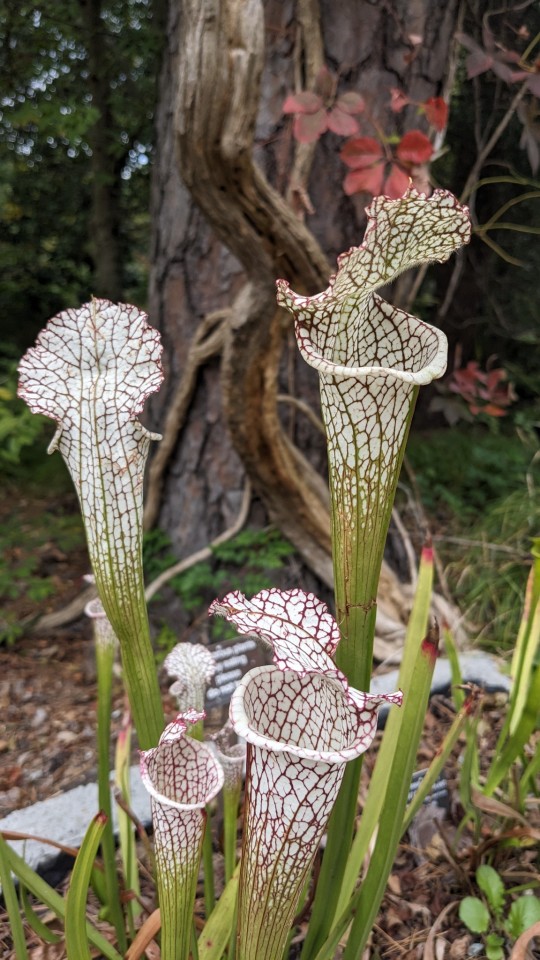#Pale Pitcherplant
Explore tagged Tumblr posts
Text

Sarracenia alata / Pale Pitcher Plant at the Sarah P. Duke Gardens at Duke University in Durham, NC
#Sarracenia alata#Sarracenia#Sarraceniaceae#Pale Pitcher Plant#Pale Pitcherplant#Pitcher plant#Pitcherplant#Native plants#Plants#carnivorous plants#Nature photography#photography#photographers on tumblr#Sarah P. Duke Gardens#Duke Gardens#Duke University#Durham#Durham NC#north carolina#🌺🌻
12 notes
·
View notes
Photo




Pale Pitcherplant (Sarracenia alata), Watson Rare Plant Preserve in the Big Thicket area of East TX, USA.
photographs by Paxon Kale
#pitcherplant#pitcher plant#plants#botany#carnivorous plants#nature#texas#north america#science#outdoors#me
67 notes
·
View notes
Text
Carnivorous Plants - They Actually Do Something - Part 2

If you are new to this series of articles, it may be helpful to read part one; a general description of carnivorous plants and Venus's Flytrap.
The North American pitcher plant, or sarracenia, is one of the most beautiful and interesting carnivorous plants. They are native to North America, and can be found along the Mississippi (purple pitcher Pitcherplant), Texas (the pale pitcher plant), Florida, and many southern states.
Remember that carnivorous plants don't just grow anywhere, but only in nutrient-low bogs. Tis why they catch and digest insects!
This CP often possesses striking colors, stately form, or both. One interesting thing about this plant is that pitcher plant can be crossed with any other pitcher plant to produce stunning hybrids.
The hybrids can then be crossed with other hybrids, or recrossed with one of the parent plants. Some growers pick their best hybrids and apply them for cultivar status. If the International Carnivorous Plant Society grants the plant cultivar status, it is then very special. A good example of a cultivar is Judith Hindle. A cross of sarracenia flava, sarracenia purpurea, and s. leucophylla. It's a study of genetics, and is included here to "wet your appetite".
Sarracenia posses a passive trap. Their traps are their leaves. The leaves are hollow with a lid, kind of like an upright, tapering paper towel roll; with a flap about an inch higher than the big end.
Between the lid and the opening to the hollow leaf (the trap is the tapering tube), there is plant tissue connecting them. On this plant tissue are nectar glands that secrete delights. Insects pick up on the scent of the nectar and land on the lid to feed.
The lid is covered with hairs that point down into the trap. This makes retaining a foothold tricky. Hopefully, for the plant, the insect will lose its footing and fall into the tube. The tube also had small downward pointing hairs making it nigh impossible for the trapped insect to break free.
Once the insect runs out of energy, it eventually settles into the tube. The leaf then secretes enzymes that digest it.

The life cycle of a sarracenia begins when a seed falls from its mother plant. Next spring, the seed starts to grow. it grows for 4-6 years (if it survives) before reaching maturity and beginning to flower.
Each year its bulb gets bigger, and its pitchers grow bigger also. The first year the pitchers are only a couple inches high, but the pitcher size doubles until the plant reaches approximately 3 years of age. After that, the pitcher slowly increases in size until maturity is reached.
As bog plants, Sarracenia is exposed to the intense sun throughout the day because there are few trees or shrubs to grow up and block it out due to a bog's poor soil.
Therefore when people grow them, they need to try and replicate the conditions where they grow naturally. Like the VFT, Sarracenia needs peat, and perlite or silica sand as a growing medium, and distilled or RO water.
Sarracenia can grow monstrous with time, producing many "growth points" or nodes where new leaves are produced. Many growers divide or cut the bulb in sections when there is more than one growing point. If each growth point has roots, it will most likely become a new plant.
0 notes
Text

Sarracenia alata / Pale Pitcher Plant at the Sarah P. Duke Gardens at Duke University in Durham, NC
#Sarracenia alata#Sarracenia#Sarraceniaceae#Pale Pitcherplant#Pale Pitcher Plant#Pitcherplant#Pitcher Plant#carnivorous plants#Native plants#Plants#Nature photography#Photography#photographers on tumblr#Sarah P. Duke Gardens#Duke Gardens#Duke University#Durham#Durham NC#north carolina#🌺🌻
3 notes
·
View notes
Text

Sarracenia alata / Pale Pitcher Plant at the Sarah P. Duke Gardens at Duke University in Durham, NC
#Sarracenia alata#Sarracenia#Sarraceniaceae#Pale Pitcher Plant#Pale Pitcherplant#Pitcher plant#Pitcherplant#Native plants#Plants#carnivorous plants#Nature photography#photography#photographers on tumblr#Sarah P. Duke Gardens#Duke Gardens#Duke University#Durham#Durham NC#north carolina#🌺🌻
2 notes
·
View notes
Text

Sarracenia alata / Pale Pitcher Plant at the Sarah P. Duke Gardens at Duke University in Durham, NC
#Sarracenia alata#Sarracenia#Pale Pitcher Plant#Yellow trumpets#Pale trumpet#Pitcher Plant#Pitcher Plants#Native plants#Carnivorous Plants#Nature photography#photographers on tumblr#Sarah P. Duke Gardens#Duke Gardens#Duke University#Durham#Durham NC#North Carolina#photography#🌺🌻#Sarraceniaceae#Pitcherplant
98 notes
·
View notes
Photo







Wildflowers found at the Watson Rare Plants Preserve in the Big Thicket of East TX, USA:
Tuberous grasspink orchid
Red Milkweed
Pink Sundew
Fewflower milkweed
Pale pitcherplant
photographs by Paxon Kale
#wildflowers#flowers#plants#botany#nature#texas#outdoors#science#north america#pitcher plant#carnivorous plants
50 notes
·
View notes